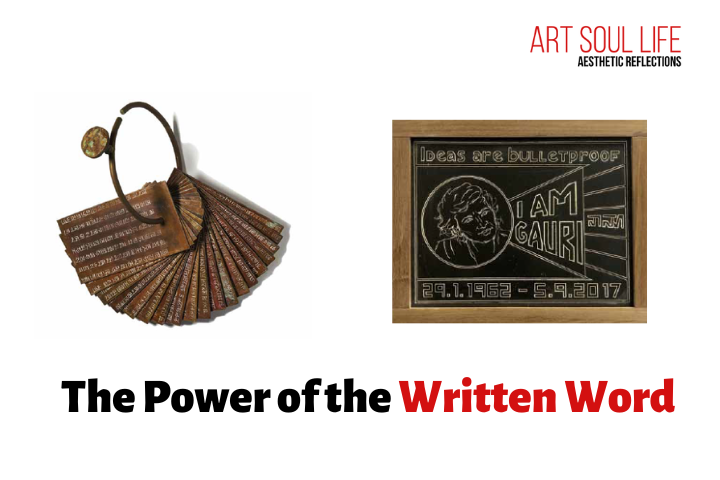
Pushpamala N’s latest solo show comprises two distinct sets of works
based on the common thread of scripts which seem contrary in nature;
one is like shasanas: a practice associated with power and the other with
resistance, says Saraswathy K Bhattathiri
One of the most thought-provoking artists in the contemporary art scene, Bengaluru-based Pushpamala N, who exhibits widely in India and abroad, works with various mediums like performance, photos, sculpture, curation and writing. In her latest solo show titled ‘Epigraphica Indica’ at Gallery Sumukha, Bengaluru, from March 12 – April 16, 2022, she displayed how the written word wields its power in everyday life. Two sets of exhibits were part of the show — ‘Atlas of Rare and Lost Alphabets (2015-2018)’ and ‘Nara/slogans (2020-2022). The former is a set of 100 installations, which was inspired by a vitrine containing ancient inscriptions incised on copper plates while on her visit to the archeological museum of Bengaluru. The act of transcribing the letters is articulated as a performative act reminiscent of scribes copying manuscripts in mediaeval libraries. She brings in references of anthropologist James C Scott’ s terminology and ideas on Hidden Transcripts, which is connected to mysterious languages of resistance and cultural preservation contextual in time. Nara is a set of 50 works that commemorates slogans and poems of recent popular protests in India. These are designed in various styles like that of Russian posters, books, dialogue boxes and graph pages using various typographies. In both the series, words and images are etched into copper plates and treated with brown and greenish patinas.
The former series takes an appearance of ancient scripts/alphabets of different languages like Kannada, Tamil, Malayalam, Urdu etc., refuting to assign to any essential meanings. She sustains a mysterious nature of the work which encloses an inability to decipher them. More than a linguistic challenge, this recalls the history of scripts that begins from primitive pictographs. Pushpamala’a work also recalls the last three decades of archival turn in contemporary art. Archives broadly are considered to be physical manifestations of history. These fabricated archives, which are mimetic versions of inscriptions, and manuscripts/shasanas, give a possibility of a humorous and fictive narrative of what happens if these were excavated in future and epigraphists struggle to decipher them. It lies somewhere between a wholesome fiction style of Eve Laramee’s works and Hanne Draboven’s notion of observing archival tendencies in cultural history. The ‘Atlas of Rare and Lost Alphabets’ moves contrary to artistic practices within the archive as it doesn’t use actual archive materials to advocate testimony or identity. The notion of authenticity/essentiality of ideas through script can see a wide range association with masculinity and hegemony embedded in the making of history and culture.
The artist associates these works with the subaltern voice, or probably a secret language formed as a resistance to hegemonic social structures that calls out for a disintegration of sound/script patterns. This is in concern that the language of the underprivileged was oral and fluid in nature. A disintegrated language is a ruin with epistemological mystery. Pushpamala recreates memoirs of Bengaluru based on the settings of ruins (of past and possible ruins of future) rather than a glorious past by taking inspiration from Walter Benjamin’s Arcades Project where he observes, Paris not as a developing city but as ruins.
Derrida in his essay Archive Fever a Freudian Impression connects ‘archive’ with both commencement (of subjects) and (gods/ men does) commandment. Rock edicts have been part of such archival practices and epistemological studies later on. Writing on rocks have therefore been historically connected to divinity or part of a hegemony related practice as in the case of Ten Commandments by Moses or Codes of Hammurabi. The Atlas series can be seen as a mutated version of what Derrida addresses. In Nara, the artist uses slates. Slate’s etymological references take us to French esclat, which means split piece: technically slates are splits of rocks. Nara’s slates address protests against discrimination and violence against women, minorities and proletarians in India in past few years. Its material influence is from rock inscription, which is older than copper plates but the sense of mobility adopted from the latter. These two works seem contrary in nature; one is like shasanas: a practice associated with power and the other with resistance. Here, the juxtaposition of these two series articulates that the slate seems to be split from monolithic rocks to give voice to the diverse and oppressed. Nara replaces erasable chalk with etching, which makes it a contemporary inscription and evokes a social discourse. Here she brings in a contrast of old ways of knowledge, which were grounded in centralised elitist attitudes and modern education, which attempts to consciously create equilibrium in future.
The Atlas series also has few botanical drawings, drawings taken from European mediaeval manuscripts, etchings of Francisco Goya and Indus Valley images. They decline illustrative assistance to the text but aids in recalling the extensive history of text and image links. Whereas in Nara, the images and texts are decipherable even for common men. This leads to linguistic contrasts as the former consist of mimetic versions of ancient Indian languages and the latter has English and Hindi; languages that contest with each other yet refer to a modern and collective sense of expression. It leads to questions like, is there a call for abandoning the past and realising the present? It fetches in an attempt for double discourse: archival as art and artworks as archives. While one can observe the emphasis on details like shaping the metal, etching, wax casting and threads on book format installations to simulate a museum work culture; which goes beyond mere representation, it faces the same issue as the reading of Freud’s Moses as historical novel based on which the implementation of archive cannot be sheltered. It seems to be in a liminus state of being an art or archive. If the work seems to call out for devising scripts for the scriptless, it might also seem to assert script as an essential aspect of epistemology.
The artist’s works are in the collections of MOMA (New York), Tate Modern (UK), NGMA, Kiran Nadar Museum of Art etc. She has also been a recipient of various prestigious awards.






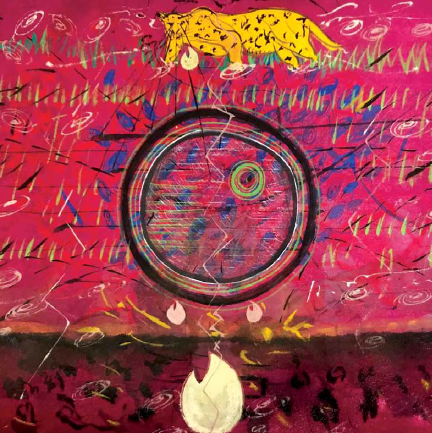
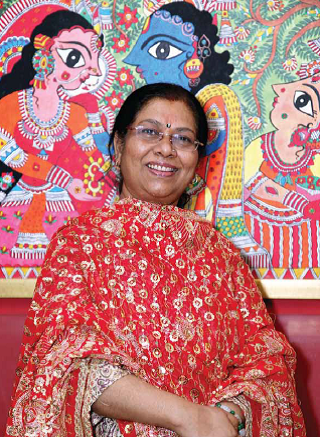

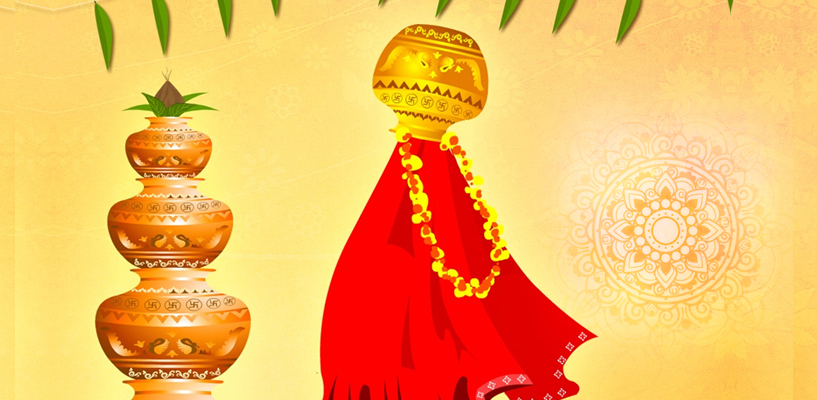 " >
" >
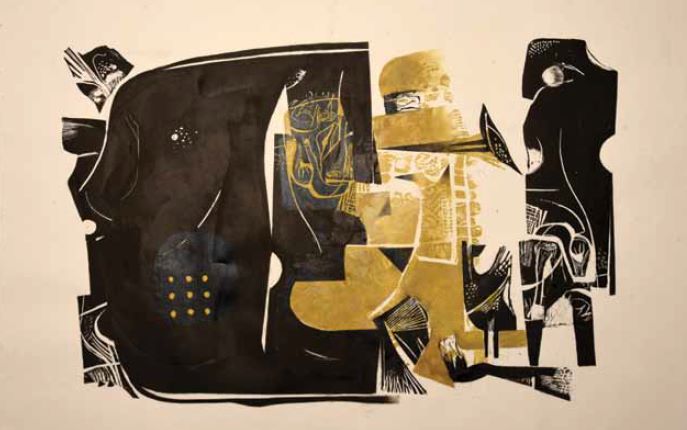 " >
" >